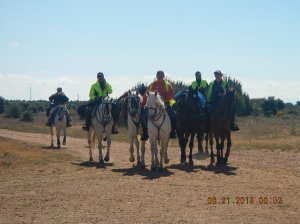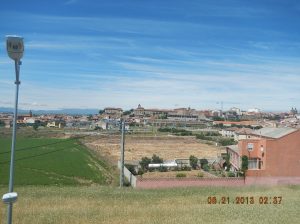Stage 23 – Hospital de Órbigo – Astorga
Total Distance – 15.0 km
Adjusted for Climb – 15.6 km (accrued ascent 125 m = .6 km)
High Point: Cruceiro Santo Toribio at 905 m (2,970 feet)
CLICK ON THE PICTURES TO ENLARGE TO FULL-SIZE
The evening before in Hospital de Órbigo I saw a beautiful rainbow outside of my bedroom window. The beauty of that sight put a smile on my face and pretty much summed up my stay. Re-invigorated by the beauty and history of the bridge, well-fed, with a clean-looking haircut and animated by the conversations with the lovely Brazilian hospitalera and Marta who was from Argentina, I awoke ready, in the best tradition of all peregrinos, ready for anything, but breakfast was to come first!

Breakfast at the Albergue San Miguel with (from left to right) a French couple, the Brazilian hospitalera, Marta and yours truly.
As Marta and I started out from Hospital de Órbigo we noticed that it was a clear and beautiful day. Soon we were on the Camino trail walking towards Villares de Órbigo as we chatted amongst ourselves in Spanish. Soon into the walk we had an opportunity to have a conversation with a Spanish farmer who was caring for his own individual plot of land. He had multiple crops planted and it was obvious that what he planted was for the private use of his family.

A beautiful copse of trees on the way to Villares de Órbigo. Marta is on the left and the peregrina on the right I was to meet later further up on the camino.
I soon was separated from Marta due to her injured foot. It had been troubling her for days and she had warned me that she would not be able to keep up with my pace. I was sad to leave her but continued on until I met a peregrina from Romania. Marta and I had seen her before on the trail but we had not had an opportunity to talk to her. Her name was Maria and I was astounded to hear her tell me that she was 82 years old! She was the oldest peregrina I had ever met and although she was struggling up the hills she was determined to continue on. I could not help but admire her fortitude and determination! She could not keep up with my pace and I did lose contact with her in the hills before Santibañez de Valdeiglesia.
Interestingly enough when doing my historical research on Santibañez de Valdeiglesia and Villares de Órbigo I could not find and mention of the history of both villages. What I did find were descriptions of the lodgings available in both places and the fact that both villages had a church with the image of Santiago Matamorros. I did find on a Spanish website a controversial back and forth discussion about which route was the “historical” Camino. Was it the one I was on or was it the route that followed the N-120? I’ll never know and it seems that neither will the participants of that discussion. When I did arrive at Santibañez de Valdeiglesia I did not spend much time there because the church was closed and I did not see much to keep me there. I did run into a group of Spanish senior-citizens from Cartagena that started their walk from the Albergue there. Soon I was past them but was to meet up with them many times on this day.
That rather stiff peregrino was at a place called Cruz del Valle. Everyone stopped here to have their picture taken and to get a little rest because the way ahead was to get a little steeper. 

It says something to the effect, “Here is your homage for those going to Santiago.” It’s hard to make out exactly because words have been crossed off.
The terrain that I encountered as I approached the extreme northwest corner of the Castilian Meseta was a combination of hills, fields of wheat and large-trunked, long-leafed, Chestnut trees.
To the west were the Montes de León and to the north was the Cordillera Cantábrica. The soil here was red and sandy because it contained minuscule traces of gold. It was the greater concentrations of gold that were found higher up in the Montes de León that the Romans mined. I saw a sign for an old mine but decided not to deviate from my path. Good thing that I didn’t because I soon made friends with a trio that consisted of an Australian husband and wife (Ian and Dena) who were travelling with Jude, an American from Kentucky. Ian and I walked ahead of Jude and Dena and we had a very nice chat as we walked together. I learned that Ian and Dena had started their Camino in León while Jude had started out in Bilbao and had taken the Camino del Norte. She told me how the Camino del Norte was not as well-marked as the Camino Francés and the terrain was steep and dangerous. It was a struggle for her to make it to Santander and she decided then and there to abandon the Camino del Norte and continue on the Camino Francés. I couldn’t blame her as I imagined what it must of been like for her early on when northern Spain was experiencing record rainfalls. Soon we noticed a slight commotion in front of us, outside of what I took to be a ramshackle building. It was La Casa de los Dioses (the House of the Gods) and the commotion was being made by the senior-citizen group that was effusively greeting Davide, the host there. Davide is an exceptionally friendly individual who has lived in a ramshackle deserted building for four years, with no running water, gas or electricity. His one and only job is to greet peregrinos and offer them refreshment and a hearty greeting.

Our host Davide, posing with members of the senior citizen group. One member of the group turned out to be the CEO for the brand of juice products that Davide stocked! The white T-Shirts have to logo of the juice company.
 Davide doesn’t ask anything in return for bringing you “Paradise on the Camino de Santiago” but he is so sociable and he has such great snacks that I believe it would be a crime not to leave a donativo.
Davide doesn’t ask anything in return for bringing you “Paradise on the Camino de Santiago” but he is so sociable and he has such great snacks that I believe it would be a crime not to leave a donativo.

Davide has quite a spread and you can have anything! Most people leave a donativo for what they have eaten or drank.
As if La Casa de los Dioses wasn’t enough excitement we were about to experience one of those surreal moments that happen on the Camino. For me it was like a scene out of one of those Westerns that Americans were so fond of in the 1960’s. To set the scene, our American/Australian group had just arrived at the Cruciero Santo Torbio – a stone cross commemorating Bishop Torbio who in the 5th century went on pilgrimage to Jerusalem and returned with a fragment of the true cross – at the cross was the Spanish group from Cartagena when suddenly in the distance – out of the blue and reminiscent of a scene from Western film – we all saw a group of horsemen (actually there was a woman amongst them) riding in our direction! The senior-citizens waved and encouraged them to pose in front of the cross with them. As this scene was unfolding in front of me I was hearing the big western-themed music that one would hear during a climatic scene in a Western film!
We saw the horses again in the next town, San Justo de La Vega. They were in an abandoned parking lot munching on some hay and attended by two riders while the rest of the group were enjoying beers in an adjoining Bar. This motivated us to seek out refreshments also! I would get an appetizer of Astorga’s substantial Roman past when we would have to cross the Roman footbridge that was in Astorga’s suburbs.

Dena and Ian leading us in to Astorga. The Roman name for the town, Asturica Augusta, is in the middle of the traffic circle
We still had a steep climb in order to really be in Astorga and as soon as we finished the climb we found ourselves in the Plaza San Francisco. It was in the Convento de Francisco that St. Francis of Assisi stayed during his pilgrimage to Santiago in 1212. No doubt he also saw the adjoining foundation of a Roman villa complete with thermal baths!

The view from the Jardin de La Sinagoga, a park that shows the city walls that were originally Roman but have been reconstructed many, many times.
My next post will amaze you with the rich history of Astorga and probably disgust you with a description of the Maragato stew that we ate just 60 meters from the Plaza San Francisco. You’ll just have to wait until tomorrow!


































